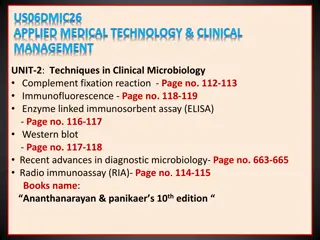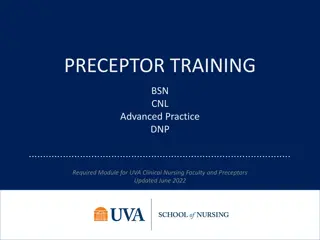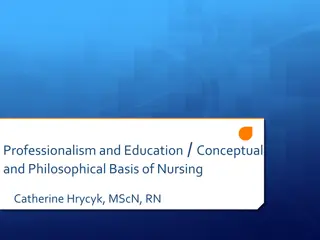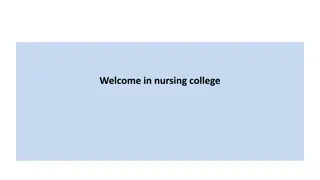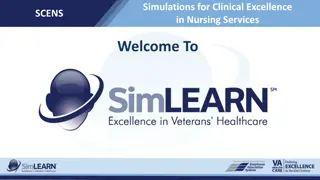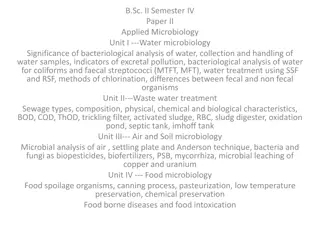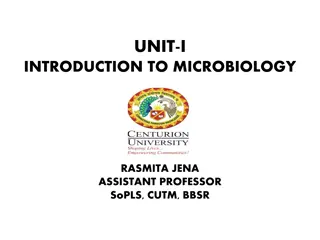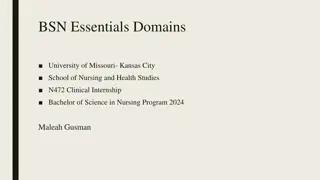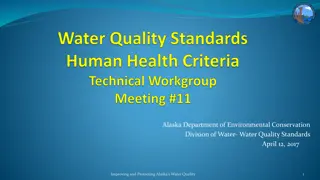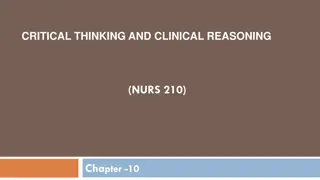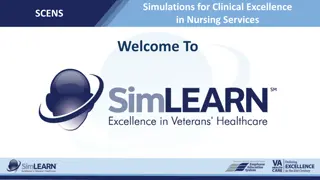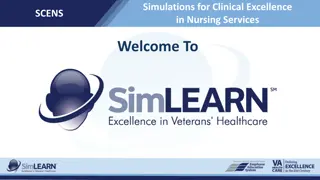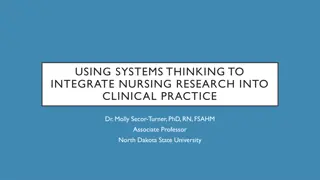Clinical Microbiology Fundamentals and Nursing Contact Hours in Alaska
Explore the basics of clinical microbiology and earn nursing contact hours in Alaska. The program covers laboratory testing, culture methods, rapid diagnostics, and non-specific lab tests for identifying infections. Connect with experts and enhance your knowledge in the field.
Download Presentation

Please find below an Image/Link to download the presentation.
The content on the website is provided AS IS for your information and personal use only. It may not be sold, licensed, or shared on other websites without obtaining consent from the author. Download presentation by click this link. If you encounter any issues during the download, it is possible that the publisher has removed the file from their server.
E N D
Presentation Transcript
Nursing Contact Hours (NCH) The Alaska Division of Public Health is an approved provider of continuing nursing education by Montana Nurses Association, an accredited approver by the American Nurse s Credentialing Center s Commission on Accreditation. There is no identified conflict of interest by any planner or presenter involved in this learning activity. In order to receive nursing contact hours: Register (sign in) and attend 80% of each day. Complete a two question evaluation form at the end of day. Contact Kim Spink at 907-269-8085 or kimberly.spink@alaska.gov for any concerns for NCH
Understanding the Basics of Clinical Microbiology. RYAN W. STEVENS, PHARM.D., BCPS INFECTIOUS DISEASES CLINICAL PHARMACY SPECIALIST PROVIDENCE ALASKA MEDICAL CENTER
Disclosures: None
Objectives: 1. Describe the utility of laboratory testing/chemistries in the workup of infection. 2. Describe general microbiologic culture and susceptibility methods and their associated time courses. 3. Describe some forms of rapid diagnostic testing (RDTs)
Learning Assessment: T/F Elevations in inflammatory biomarkers including (ESR, CRP, PCT, and WBC) indicate the presence of an infectious condition. Which of the following is a catalase positive, coagulase positive, latex positive GPC? Staphylococcus aureus Streptotoccus pyogenes Staphylococcus epidermidis Streptococcus pneumoniae Which susceptibility testing method provides a formal MIC? (circle all that apply) Broth microdilution (BMD) Epsilometer test (E-test) Kirby-Bauer disk diffusion 1. 2. 3.
Non-specific Lab Tests:1,2 There is NO single definitive test for identification of infection! i.e. All have limitations Always should be paired with clinical presentation. Examples: White Blood Cell (WBC) Count: Elevate in response to infection Also elevate in response to: Drugs (i.e. steroids), stress, inflammation, etc. Bands = immature neutrophils Left Shift : >9% bands Lactate: Demonstrates shift to anaerobic metabolism / illustrates tissue hypoperfusion Elevates in response to shock, tissue ischemia, severe liver disease, and some medication (metformin)
Non-specific Lab Tests:1-3 CRP and ESR: C-reactive protein (CRP) and erythrocyte sedimentation rate (ESR: Non-specific acute phase reactant (i.e. non-specific inflammatory marker) Elevate vaguely in response to inflammation Generally CRP reacts faster than ESR Better for trending chronic infections vs. determining if infection present. Erythrocyte sedimentation rate (ESR) Non-specific inflammatory marker Generally reacts slower than CRP Procalcitonin: 116 amino acid precursor of calcitonin More sensitive than CRP at detecting bacterial infection Detectable in 2-4 hours / Peak = 8-24 hours / Half-life = 24 hours Rises not impaired by neutropenia or immunosuppression Most useful in community-acquired lower respiratory tract and sepsis
Non-specific Lab Tests:4,5 Urinalysis: Color and Clarity: Non-specific Nitrites: Reductase: Nitrates Nitrities Weakly sensitive/highly specific for the PRESENCE of bacteria. Leukocyte Esterase: Produced by neutrophils Indicates pyuria WBC: Grades the pyuria Bacteria: May signal contamination, ASB, or infection Squamous Epithelial Cells: May help determine quality of specimen.
Asymptomatic Bacteriuria (ASB):5 No mater what Bear Grylls tells you urine is not a sterile body fluid. A dirty UA or pyuria in the absence of symptoms is NOT an indication for antimicrobial therapy. Caveats: Pregnancy ASB during procedures which will compromise of urinary mucosa.
Culturesthe basics:1,6-9 Only culture something if you plan to use the culture to guide therapy. 1. May NOT always be necessary (i.e. uncomplicated CAP or perforated appendicitis) Always culture PRIOR TO administration of antibiotics if possible. 2. Sepsis is the obvious exception 7.6% increase in mortality for every hour antimicrobial therapy is delayed. Take care to avoid contamination with patient s usual flora. Interpret cultures with a critical eye: 3. 4. What source/type of culture was obtained? What was the culture method? What did the gram-stain/grouping show? What grew? Does what grew match the clinical suspicions? What did susceptibilities show?
Culture Source/Type:1 Source: Blood Wound, bone, tissue, abscess CSF Respiratory Stool Urine Body fluid (pleural, ascites, etc.) Type: Aerobic Anaerobic Fungal Acid fast bacilli
Culture Source/Type:1 Some variance in microbiology processing: BACTEC alert device Blood Gram-stain negative Body Fluids Required additional processing: Tissue Bone Straight to plate Wound Respiratory Urine Gram-stain positive CSF
Culture Source/Type:1,8-11 Anticipate pathogen based on location of infection. Skin and Soft Tissue Source: Skin flora (Staphylococcus/Streptococcus) Respiratory Source: S. pneumoniae, M. catarrhalis, L. pneumophila, M. Pneumoniae, C. pneumoniae, H. influenzae. Hospital-acquired: MDRO gram-negative rods (including P. aeruginosa) and S. aureus GI Source: E. coli, Klebsiella spp., B. fragilis, S. anginosus, Enterococcus spp.
Culture Method:10-14 How was it collected? Is it a good specimen? Could it be contaminated? Respiratory: Sputum (expectorated) vs. sputum (suction) Endotracheal aspirate vs. Bronchoalveolar lavage (BAL) vs. mini-BAL Wounds: Purulent vs. Non-purulent Superficial swab vs. tissue/biopsy Chronic ulcer vs. acute wound Blood: ? Contaminant How many bottles of how many draws? How long did it take to grow? General features: Look for presence of WBC Look for absence of squamous epithelial cells
Culture Method:15 Semi- quantitative: Attempts to ESTIMATE the quantity of organisms in a given culture. Quantitative: Provides more robust estimate of number of organisms in a given culture. Requires fluid specimen. Cultures plated in one quadrant on plate Growth in primary quadrant = 1+ Extension characterized as 2+, 3+, and 4+ One mL of specimen is plate in plated and depending on growth on streak estimate made. i.e. >100,000 cfu/mL http://intranet.tdmu.edu.ua/data/cd/dis k2/ch010.htm
Gram Stains:1 Specimen applied to slide Crystal violet stain applied followed by iodine. Alcohol decolorizing solution applied Counterstain with safranin Gram-negative: Red/Pink Gram-positive: Purple in appearance
Gram Stains:16 Grouping: More relevant in gram positive cocci (GPC): Staphylococcus spp. GPC pairs, tetrads, and clusters Streptococcus spp. / Enterococcus spp. : Generally: GPC in chains LONG chains Beta-hemolytic strep or S. viridans Diplococci and chains S. pneumonia What about GPC pairs?
Gram Stains x 2: Specimen received Initial gram stain (1-6 hours) Plated and grown (24-48 hours) Growth gram stain Organism identification (0-24 hours) Susceptibilities (18-24 hours)
Gram Stains Plate Growth:
Plate Growth: Identification what is taking so long? Pure plates vs. mixed plates re-isolating for more information Poor vs. no plate growth plates Oddly behaving organisms
Plate Growth (GNR):17 Gram Negatives: Lactose fermentation: Helps to distinguish between GNRs prior to formal ID. Pseudomonas vs. other MacConkey agar: Inhibits gram-positive growth Lactose Fermenting: Lowers pH red agar Non-lactose fermenting: Ammonia production raises pH Clear/opaque agar https://en.wikipedia.org/wiki/MacConkey_agar #/media/File:MacConkey_agar_with_LF_and_L F_colonies.jpg
Plate Growth (GNR):17 Oxidase: Assesses for presence of cytochrome oxidase Not produced by Enterobacteriaceae Produced by pseudomonas Positive test = Purple stain i.e. agent is oxidized Negative test = Colorless i.e. agent remains reduced http://www.medical-labs.net/oxidase-test-1291/
Plate Growth (GPC):17 Catalase: 2H2O2 O2 + H2O O2 released as gas = bubbles Differentiates staphylococcus from streptococcus Staphylococcus = catalase positive Streptococcus = catalase negative http://4.bp.blogspot.com/- pGWy_YzoaD4/UZXnPopWsUI/AAAAAAAAAH0/nrnpu- kKutg/s1600/slide+catalase+test+results.jpg
Plate Growth (GPC):17 Catalase positive: Latex agglutination: Antibody for S. aureus on latex beads Latex positive = S. aureus Latex negative = CoNS Coagulase: Converts fibrinogen to fibrin clot with help of plasma factors S. aureus = positive S. epidermidis and other CoNS = negative Catalase negative: Hemolysis: Does it growth cause hemolysis of blood agar Alpha = green = partial hemolysis S. viridans S. pneumonia Maybe S. anginosus Beta = clear = full hemolysis Typeable streptococcus Group A, B, C, G Gamma = red = no hemolysis Enterococcus spp. (PYR) Maybe S. anginosus
Organism Identification: Specimen received Initial gram stain (1-6 hours) Plated and grown (24-48 hours) Growth gram stain Organism identification (0-24 hours) Susceptibilities (18-24 hours)
Organism Identification: VITEK vs. Microscan vs. Phoenix PAMC = VITEK2 Performs both: Organism identification Susceptibilities Automated broth microdilution (BMD) We will come back to this!
Organism ID vs. Clinical Suspicion: Culture Source Method of Collection Suspicion for Contamination Gram stains Growth Organism ID Presence of Usual flora? Odd organism for culture source? Growth that doesn t match the initial gram stain? Initial gram stain that doesn t match the growth?
Susceptibilities: Specimen received Initial gram stain (1-6 hours) Plated and grown (24-48 hours) Growth gram stain Organism identification (0-24 hours) Susceptibilities (18-24 hours)
Susceptibilities:1 Qualitative Results: Driven by MIC Actual determinant behind quantitative results Multiple methods (BMD vs. KB vs. E-test) Quantitative Results: Susceptible Intermediat e Resistant Valuable but sometimes hard to interpret. User friendly but perhaps
Semi -Qualitative Susceptibilities:1 Disk diffusion test (i.e. Kirby Bauer) Grow bug Drop Disk Measure zone of inhibition Susceptibility of organism is determined by zone of inhibition Determined by CLSI standards Varies depending on organism Varies depending on drug Generally: Bigger zone of inhibition = more susceptible bug Can perform multiple tests (up to 12) on same plate Able to choose specific agents to test Pros: Reliable, flexible, cheap, and simple Cons: May be impacted by incubation temp or bacterial inoculum
Qualitative Susceptibilities:1 Minimum Inhibitory Concentration: The lowest antimicrobial concentration that prevents visible growth of an organism after ~24 hours of incubation in a specified growth medium Susceptibility breakpoints determined by CLSI Traditionally Macrotube dilution method vs. Solid agar Labor intensive! Present day: Automated VITEK2 vs. Microscan (turbidity) vs. Phoenix Epsilometer Test (I.e. E-test) Tells us the level of susceptibility of an organism rather than just the interpretation of that level. E. coli: Piperacillin/tazobactam </= 4 vs. 32 mcg/mL MRSA: Vancomycin <0.5 vs. 2 mcg/mL
Qualitative Susceptibilities:1 Automated Broth Microdilution (BMD): Inoculate card Put in machine Wait Tests organism to multiple concentrations of multiple drugs Drugs in card determined by manufacturer or card selected. Determines organism MIC to multiple agents in single test Run time = 18-24 hours Pros: Easy, reliable, provides formal MIC Cons: Requires machine ($$$) and lacks flexibility in agent selection.
Qualitative Susceptibilities:1,18 Epsilometer test (i.e. E-test) Grow bug Drop strip look for ellipse/strip intersection. E-Strip: Single agent Increasing concentrations One strip per plate. Has been at times to be more accurate than automated broth microdilution Pros: Easy to perform, ? Easy to read, cheap Cons: One per plate, ? Easy to read
Susceptibilities: Summary: Do you have qualitative, quantitative, or both? If qualitative, was it performed via BMD, E-test, or Kirby-Bauer? If BMD or E-test, just how susceptible was the organism (i.e. what was the MIC)? 1. 2. 3. Select a therapy! What is the narrowest spectrum agent that treats all presently identified organisms? 1.
Rapid Diagnostic Testing:17 Sensitivity vs. Specificity Varies depending on testing method and specific test Sensitivity: Specificity: If a person HAS the disease how often will the test be positive? If a person does NOT HAVE the disease how often will the test be negative. I.e. I.e. 10 influenza patients present and are swabbed for EIA 10 patients WITHOUT influenza present and are swabbed for EIA Rapid flu swab (EIA) detects 5/10. Rapid flu swab (EIA) detects 2/10 Sensitivity = 50% Specificity = 80% Rate of true positive vs. false negative. Rate of true negative vs. false positive.
Rapid Diagnostic Testing (RDT):17 Antibody testing: Agglutination testing: Antibodies (polyclonal or monoclonal) attached to latex beads and specimen introduced. If lattice structure forms then antigen is present (antibody-antigen complexes) Typically tested from growth (not generally from direct specimen) Ex: S. aureus from plate growth Enzyme immunoassay (EIA)/Enzyme-linked immunosorbent assay (ELISA): Antibody coated wells/trays Specimen (antigen) introduced Well washed out Second antibody introduced well washed out coloring agent added. Wells that change color = positive for antigen. Typically tested direct from specimen Ex: Influenza A and B, Ag EIA (i.e. rapid flu swab)
Rapid Diagnostic Testing (RDT):1,17 Polymerase Chain Reaction (PCR / NAAT): Testing done directly from collection specimen Target amplification system Amplifies SMALL sections of DNA using DNA polymerase and short oligonucleotide primers for detection. If more than one primer used = improved sensitivity (multiplex PCR) Ex: Respiratory viral pathogen panel (BiofireTM) Blood Culture Identification Panel (BCID) GI Panel Meningitis/Encephalitis Panel C. diff, NAAT 16S rRNA: Looks for specific section of ribosomal RNA that helps to identify specific organisms in a specimen. Draws on LARGE bank of known sequencing vs. specific testing on specific platform Testing of direct specimen
Rapid Diagnostic Testing (RDT):17 Mass Spectrometry: Matrix-assisted laser desorption ionization time-of- flight (MALDI-TOF) Thin smear on metallic slide Hit with pulses of laser Desorbed and deionized particles then accelerated through electrostatic field and drifted through vacuum tube Contact mass spectrometers detector Different particles fly at different speeds which indicates the presence of components of specific organisms Typically run off of organism growth
Rapid Diagnostic Testing (RDT):19 Accelerate Diagnostics PhenoTM Gel electro-filtration (GEF) Sample loaded into gel well that contains pores smaller than bacterial cells Electric current applied which removes cellular debris to isolate/concentrate bacterial cells Electro-kinetic concentration (EKC) Cells are drawn to surface where analysis will take place by exposure to mild electric charge. FISH (Fluorescence in-site hybridization) Cells exposed to probes with fluorescent tags looking for specific nucleic acid sequences. Fast phenotypic susceptibility testing Cell exposed to single concentration of agent and time lapse imaging correlates growth patterns to MICs.
Learning Assessment: T/F Elevations in inflammatory biomarkers including (ESR, CRP, PCT, and WBC) indicate the presence of an infectious condition. Which of the following is a catalase positive, coagulase positive, latex positive GPC? Staphylococcus aureus Streptotoccus pyogenes Staphylococcus epidermidis Streptococcus pneumoniae Which susceptibility testing method provides a formal MIC? (circle all that apply) Broth microdilution (BMD) Epsilometer test (E-test) Kirby-Bauer disk diffusion 1. 2. 3.
References: Rybak M, Aeschlimann JR. Laboratory tests to direct antimicrobial pharmacotherapy. In: Dipiro JT et al. Pharmacotherapy: A Pathophysiologic Approach 7thed. New York, NY: McGraw Hill Medical; 2008: 1715- 1730. 1. Pagana KD, Pagana TJ. Mosby s Diagnostic and Laboratory Reference. 9th ed. Williamsport, PA: Mosby Elsevier; 2009. 2. Simon L, et al. Serum procalcitonin and CRP levels as biomarkers of bacterial infection: a systematic review and meta-analysis. CID 2004;39:206-217. 3. Simerville JA, Maxted WC, Pahira JJ. Urinalysis: a comprehensive review. Am Fam Physician. 2005;7(6):1153-1162. 4. Nicolle LE, Bradley S, Colgan R, et al. Infectious Diseases Society of American guidelines for the diagnosis and treatment of asymptomatic bacteriuria in adults. CID 2005;40:643-54. 5. Kumar A, Roberts D, Wood KE, et al. Duration of hypotension before initiation of effective antimicrobial therapy is the critical determinant of survival in human septic shock. Crit Care Med 2006;34(6): 1589-96. 6. Septimus E. Clinician guide for interpreting cultures. Centers for Disease Control and Prevention Web site. http://www.cdc.gov/getsmart/healthcare/implementation/clinicianguide.html. Published April 7, 2015. Updated April 7, 2015. Accessed October 5, 2016. 7. Mandell LA, Wunderink RG, Anzueto A, et al. Infectious Diseases Society of American/American Thoracic Society Consensus Guidelines on the management of community-acquired pneumonia in adults. CID 2007;44:S27-72. 8. Solomkin JS, Mazuski JE, Bradley JS, et al. Diagnosis and management of complicated intra-abdominal infection in adults and children: guidelines by the Surgical Infection Society and the Infectious Diseases Society of America. CID 2010;50:133-64. 9. Kalil AC, Metersky ML, Klompas M, et al. Management of adults with hospital-acquired and ventilator- associated pneumonia: 2016 clinical practice guideline by the Infectious Diseases Society of America and the American Thoracic Society. CID 2016. doi: 10.1093/cid/ciw353. 10.
References: Stevens, DL, Bisno AL, Chambers HF, et al. Practice guidelines for the diagnosis and management of skin and soft tissue infections: 2014 update by the Infectious Diseases Society of America. CID 2014. doi: 10.1093/cid/ciu296. 11. Lipsky BA, Berendt AR, Cornia PB, et al. 2012 Infectious Diseases Society of America Clinical Practice Guideline for the diagnosis and management of diabetic foot infections. CID:54(12):e132-e173. 12. Bowler PG, Deurden BI, Armstrong DG. Wound microbiology and associated approaches to wound management. Clin Microbiol Rev 2001;14(2):244-269. 13. Hall KK, Lyman JA. Updated review of blood culture contamination. J Clin Microbiol 2006;19(4):788-802. 14. Kallstrom G. Are quantitative bacterial wound cultures useful? J Clin Microbiol 2014;52(8):2753-2756. 15. Barenfanger J, Drake CA. Interpretation of gram stains for the nonmicrobiologist. Lab Med 2001;7(32): 368-375. 16. Brooks GF, et al. Medical Microbiology 26thed. New York, NY: McGraw Hill Medical; 2013 17. Rybak M, Vidaillac C, Sader HS. Evaluation of vancomycin susceptibility testing for methicillin-resistant staphylococcus aureus: comparison of Etest and three automated testing methods. J Clin Microbiol 2013;51(7): 2077-81. 18. Accelerate Pheno System. Accelerate diagnostics. Available at: http://acceleratediagnostics.com/products/accelerate-pheno-system/#features. Accessed December 30th, 2016. 19.
Environmental Cleaning and Disinfection Bonnie Barnard, MPH, CIC, FAPIC Interim Infection Preventionist
Objectives Describe the process for cleaning patient rooms daily and upon discharge Explain the importance of dwell/contact time in relation to the use of disinfectants List at least five high touch items in the patient s environment that require special attention to cleaning















